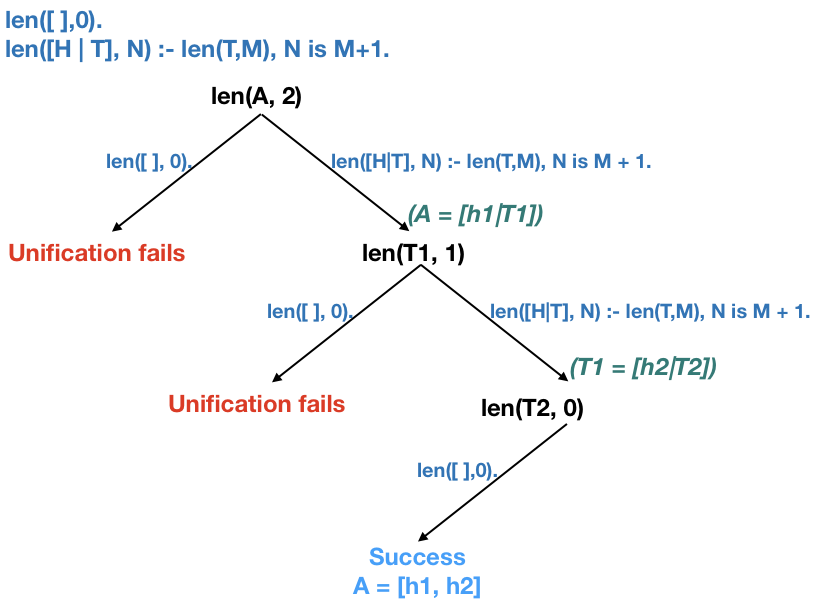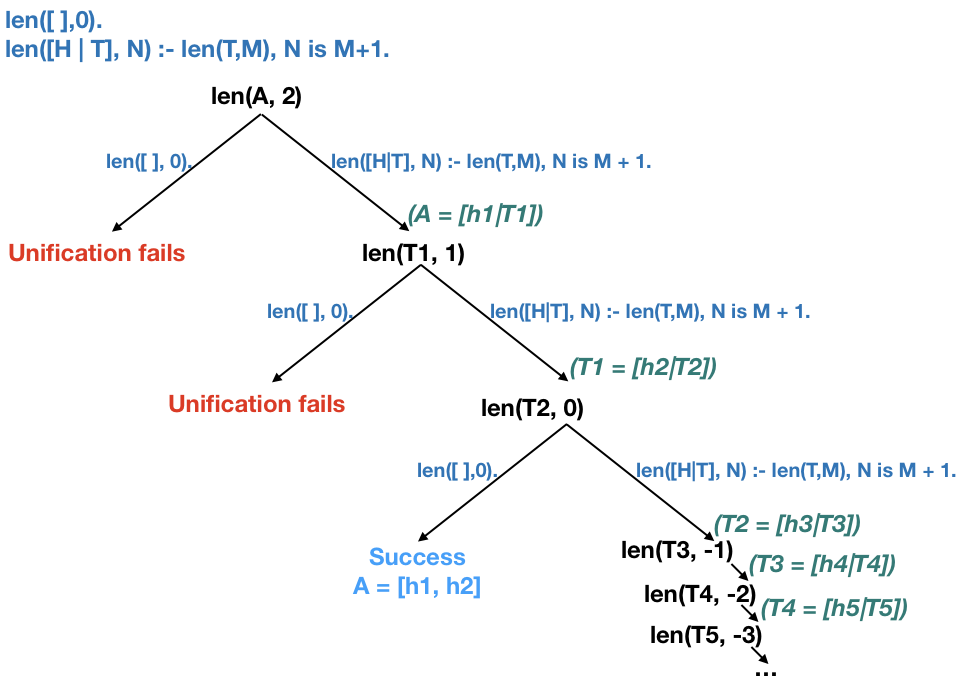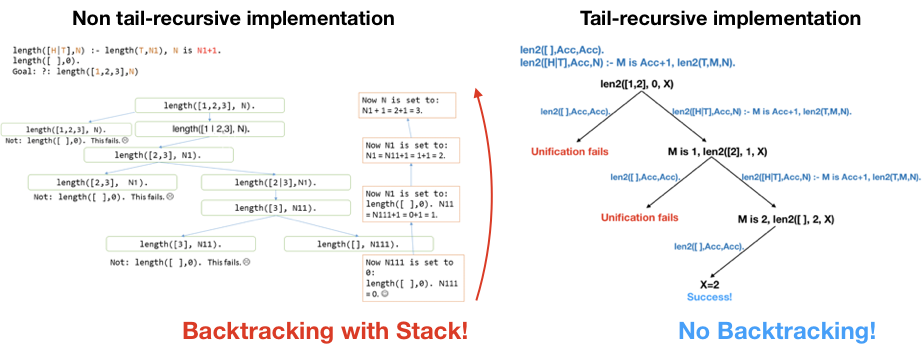Programming with Lists
CS314
Support for lists in Prolog¶
- Notated with square brackets
[1,2,3,4]. - The empty list is
[]. - List pattern matching is
[H | T], whereHis a list element andTis a list.- Can also match
[1,2,3 | T].
- Can also match
Finding the last element of a list¶
last([H],H).
last([_ | T], V) :- last(T, V).
?- last([1,2],X).
Quiz¶
The last element of a list:
last([H],H).
last([_ | T], V) :- last(T, V).
What happens if I ask for last([],X)?
A. pattern match exception.
B. Prolog says false.
C. Prolog says true, X = [].
D. Prolog says true, X = ???.
Quiz¶
The last element of a list:
last([H],H).
last([_ | T], V) :- last(T, V).
What happens if I ask for last([],X)?
A. pattern match exception
B. Prolog says false. ✓
C. Prolog says true, X = [].
D. Prolog says true, X = ???.
Arithmetic¶
- How do we compute the length of the list?
- We need support for arithmetic.
- Arithmetic is quite natural in imperative and functional paradigms.
- Since computation is deduction in logic programming (unification), arithmetic is quite special.
Arithmetic equality != Unification¶
= operator is used up by unification.
?- A = 1+2.
?- 1+2 = 3.
?- A = money+power.
Use the is operator¶
The “is” operator tells prolog to evaluate the righthand expression numerically and unify with the left.
?- X is 1, A is X+2, X is 2.
?- A is money+power.
Restriction on is operator¶
The RHS must be a ground term (no variables).
?- A is B+2.
?- 3 is B+2.
Arithmetic¶
There is support for +,*, /, <, =<, >, >=,etc.
?- X is 20/20.
Length of list¶
Compute the length of a list.
len([],0).
len([H | T], N) :- len(T,M), N is M+1.
?- len([1,2,3],X).
Backtracking¶
The way prolog produces results for the given query is through Backtracking.

Choice Points¶
- Choice points are locations in the search where we could take another option.
- If there are no choice points left then Prolog doesn't offer the user any more answers

Quiz¶
len([],0).
len([H | T], N) :- len(T,M), N is M+1.
?- len([1,2],X).
X = 2 .
What is the first result of query len(A,2)?
- Error due uninstantiated arithmetic expression.
- A = [h1,h2]
- Query runs forever
- Error due to invalid arguments
Quiz¶
What is the first result of query len(A,2)?
- Error due uninstantiated arithmetic expression.
- A = [h1,h2] ✓
- Query runs forever
- Error due to invalid arguments

Quiz¶
len([],0).
len([H | T], N) :- len(T,M), N is M+1.
?- len(A,2).
A = [h1,h2] ;
...
What is the second result of query len(A,2)?
- Error due uninstantiated arithmetic expression.
- A = [h1,h2]
- Query runs forever
- Error due to invalid arguments
Quiz¶
What is the second result of query len(A,2)?
- Error due uninstantiated arithmetic expression.
- A = [h1,h2]
- Query runs forever ✓
- Error due to invalid arguments

Limiting the number of results¶
len([],0).
len([H | T], N) :- len(T,M), N is M+1.
?- len(A,2).
?- len(A,2) {1}.
Last call optimization¶
lenuses O(N) stack space.

Tail recursive length¶
- Define a function
len2(List, Acc, Len)such thatlen2(List, Acc, Len)is true if the sum of the length ofListandAccis euivalent toLen.
len2([],Acc,Acc).
len2([H|T],Acc,N) :- M is Acc+1, len2(T,M,N).
?- len2([1,2],0,X).

Predicate Overloading¶
len2([],Acc,Acc).
len2([H|T],Acc,N) :- M is Acc+1, len2(T,M,N).
len3(L,X) :- len2(L,0,X).
?- len3([1,2,3],X).
Last Call Optimization¶
- This technique is applied by the prolog interpreter
- We can only do this if the rule is determinate up to a choice point
- No further choices for the rule

List append¶
e.g. append([1,2], [3,4], [1,2,3,4])
append([],Q,Q).
append([H | P], Q, [H | R]) :- append(P, Q, R).
?- append(Y,X,[1,2,3,4]).

List Sum¶
Compute the sum of the list. This is the example we saw in the first Prolog lecture.
sum([],0).
sum([H | T], N) :- sum(T,M), N is M+H.
?- sum([1,2,3],X).
?- sum(X,0) {1}.
Prefix and Suffix¶
<-------X-------->
+-------------------------------+
| | S | |
+-------------------------------+
<--------------Z---------------->- prefix X of Z.
- suffix S of X.
Prefix and Suffix of list can be defined using append.
prefix(X,Z) :- append(X,Y,Z).
suffix(Y,Z) :- append(X,Y,Z).
Prefix and Suffix¶
?- prefix(X,[1,2,3]).
?- suffix(X,[1,2,3]).